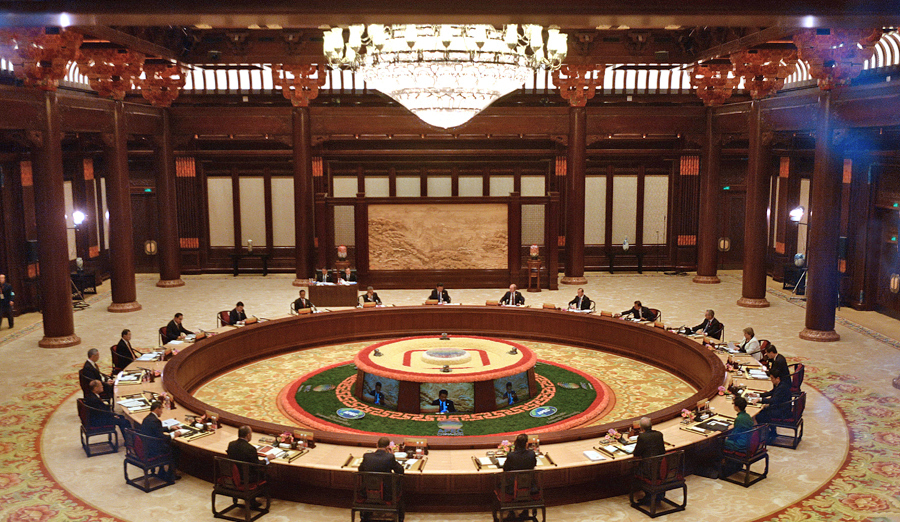China backs FTAAP to deepen Asia-Pacific integration

The 22nd APEC Economic Leaders’ Meeting was held at the Yanqi Lake International Convention Center on November 11 in Huairou District, Beijing.
The 22nd Asia-Pacific Economic Cooperation (APEC) Economic Leaders’ Meeting was held at the Yanqi Lake International Convention Center on November 11 in Huairou District, Beijing. Leaders of APEC member states exchanged in-depth views on the topic of “Co-build the Future-oriented Asia-Pacific Partnership.” They also jointly discussed major plans on regional economic cooperation and reached broad consensus.
The meeting also issued two landmark documents: “The 22nd APEC Economic Leaders’ Declaration: Beijing Agenda for an Integrated, Innovative and Interconnected Asia-Pacific” and “The Statement on the 25th Anniversary of APEC: Shaping the Future through Asia-Pacific Partnership.”
Emerging concepts raised by China
The APEC economic leaders’ meeting week between November 5 and 11 involved various activities, including the senior officials’ meeting, ministerial conference, CEO summit and economic leaders’ meeting.
Since its founding in 1995, APEC has made fruitful achievements in terms of economic development, welfare improvement, common prosperity, liberalization and convention of commerce trade and investment, and cooperation in economic technology. After weathering the Asia Financial Crisis from 1997 to 1999 and Global Financial Crisis from 2007, APEC members are still regarded as the significant engine for advancing global economic growth.
In order to further develop the Asia-Pacific region, cooperation must be broadened and made more open. Before the Beijing meeting, some concepts of APEC were initially brought up by China, attracting the attention of the world. These concepts included the global value chain, “blue” economy and Internet economy.
Finally, important consensus in various areas was reached at the APEC Economic Leaders’ Meeting. Leaders approved important cooperation initiatives on global value chains, supply chains and capacity building, support for multilateral trading system and the early of the Doha Round negotiations. They agreed to support cooperation on overleaping the middle-income trap, advancing the Internet economy and promoting sustainable growth of urbanization. They agreed to strengthen cooperation on the “blue” economy, the “green” economy, sustainable energy, small- and medium-sized enterprises, health, forestry, mining, food security, tourism, women’s issues and economic issues. They also agreed to cooperate on cracking down on corruption in the Asia-Pacific by establishing APEC’s Network of Anti-Corruption Authorities and Law Enforcement Agencies (ACT-NET), and reached consensus on pursuing fugitives, recovering criminal proceeds and engaging in law enforcement cooperation.
FTAAP on the way
“We have decided to start and advance the process of the Free-Trade Area of the Asia-Pacific (FTAAP) and approved the Roadmap for APEC’s Contribution to the Realization of an FTAAP,” said Chinese President Xi Jinping at the APEC Economic Leaders’ Meeting.
The international community has long anticipated this breakthrough, Xi said. “This is a substantive move we have made towards the FTAAP. It marks the official launch of the FTAAP process and demonstrates the confidence of APEC members in promoting regional economic integration and their commitment,” he said.
The FTAAP concept was first raised in 2006. Concrete steps towards the realization of the FTAAP were included in the 2010 APEC Leaders’ Declaration following the bloc’s summit in Yokohama, Japan. This year marks the official launch of the FTAAP process. It carries the common expectation of the 2.8 billion people within the Asia-Pacific region, taking regional economic cooperation to a new level, delivering gains to all regional economies, and injecting new impetus to the economic growth of the Asia-Pacific and common development of APEC members.
In recent years, different regional free-trade zones have been rapidly booming, distracting the attention of APEC members and complicating economic cooperation within the Asia-Pacific region. Before the Beijing APEC meeting, some Western media voiced suspicion about the FTAAP.
A landmark document, namely the APEC Connectivity Blueprint for 2015-2025, was also issued at the 22nd APEC Economic Leaders’ Meeting. Through the blueprint, members will commit to strengthening physical, institutional and people-to-people connectivity by taking agreed actions and meeting agreed targets by 2025, with the objective of creating a deeply integrated Asia-Pacific region.
New starting point
Asia-Pacific regional economic integration is facing unprecedented opportunities and challenges. In the context of booming global and regional economic cooperation, all APEC members should urgently look for new growth points and impetus amid the post crisis period.
Li Xiangyang, director of the National Institute of International Strategy at the Chinese Academy of Social Sciences, said that both developed and developing members should fundamentally rely on innovation to step out of the international crisis. The region also faces the issue of determining a new sustainable development path to enter a new round of growth, added Li.
Through the Beijing Agenda and the Statement on the 25th Anniversary of APEC, people can clearly see the development direction, mission and measure of economic cooperation within the Asia-Pacific region.
Shamshad Akhtar, United Nations under-secretary-general and executive secretary of the Economic and Social Commissions for Asia and the Pacific, gave a positive evaluation of the region’s connectivity. She noted upgrading infrastructure construction is indispensable to connectivity, adding that APEC and other international organizations should play key roles in strengthening institutional and people-to-people connectivity.
Zhang Lijun, chairman of the China APEC Development Council, claimed that the Beijing APEC meeting paved the way for all-round integration, ensuring the Asia-Pacific region maintains its leading role in global economic development.
